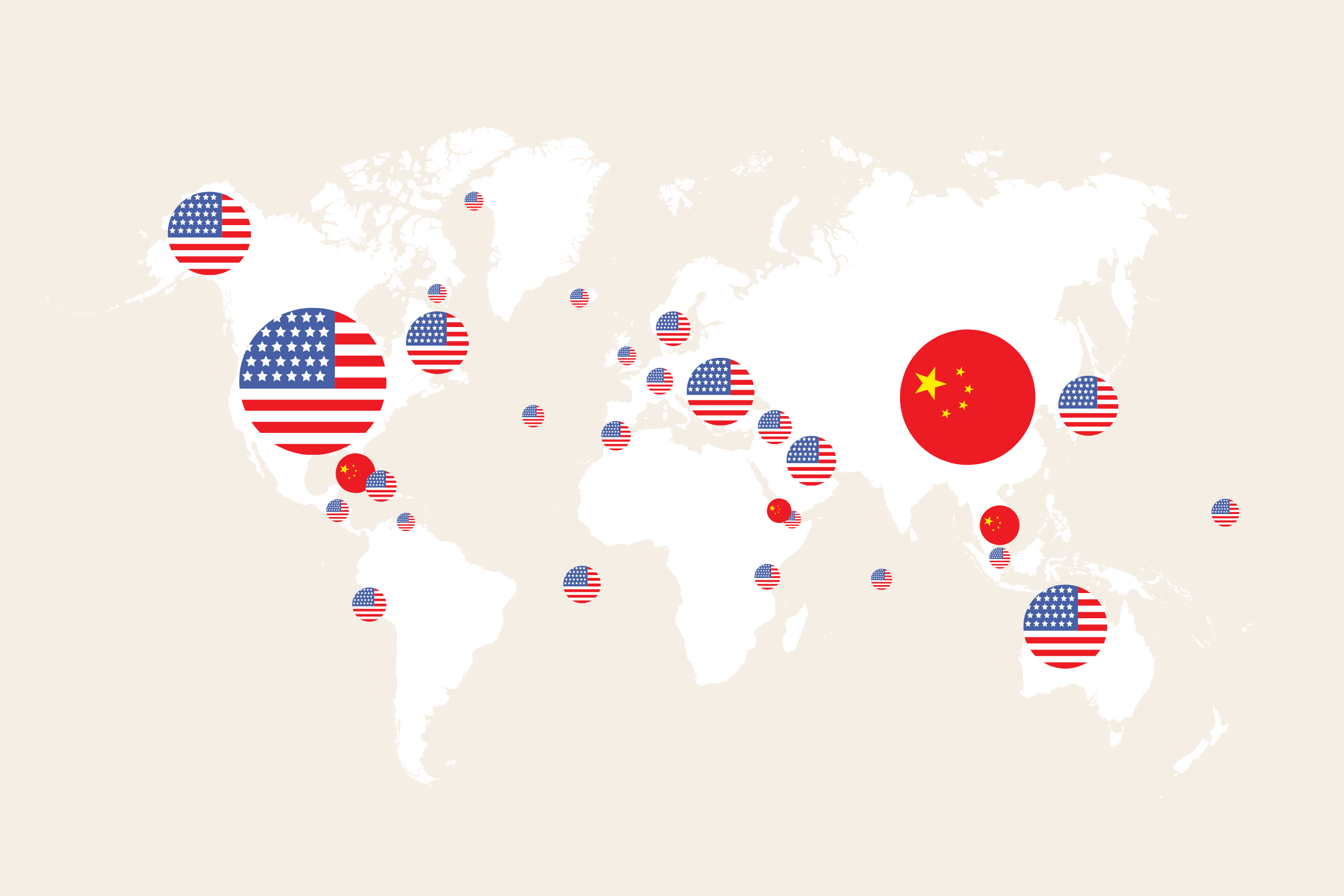World
Where in the world are U.S. and China’s militaries?

The United States is a global superpower sustained by hundreds of military sites around the world. By the end of this decade, China could have a burgeoning network of its own.
American warfighting doctrine begins in peacetime with an enduring or rotational presence at strategic locations outside the continental United States—airfields, seaports and camps, as well as arms depots, administrative offices and housing complexes—often in allied, friendly or neutral territory.
This global posture has been maintained for decades in the name of defending the national interest, and the great power model is likely to be replicated by China, in full or part, as its own economic and security interests grow.
U.S. soldiers, sailors and airmen operate out of overseas bases that contain multiple sites, but not every site is a military base. Unclassified material, such as the Pentagon’s annual Base Structure Report, also records ownership of recreational areas including parks and golf courses.
The only official guide to U.S. facilities worldwide is published at the end of each fiscal year by the Office of the Assistant Secretary of Defense for Energy, Installations, and Environment, which oversees all military sites used by the U.S. Defense Department.
Newsweek‘s interactive map marks in blue the city or locality nearest to individually listed military sites outside the U.S., or U.S. territory, as well as the service branch that utilizes it. Chinese sites are shown in red, with probable sites shown in pink.
American military sites at key regional hubs like Hawaii or Guam, the U.S.’s westernmost point, were not included in the overseas presence map. Similarly, China’s militarized artificial islands in the Spratly and Paracel archipelagos in the South China Sea were excluded.
As of September 2023, more than 40 countries and territories hosted U.S. sites that were either larger than 10 acres or valued at over $10 million. Together, they represented less than 10 percent of the Pentagon‘s total inventory of 4,800 sites, on nearly 26.8 million acres of land, worth some $2.2 trillion.
Among the sites are disused facilities still under U.S. jurisdiction or awaiting disposal. In one example likely to change the next calculation, the U.S. military this week handed over an American-built air base to Niger’s ruling junta, which gave U.S. troops until mid-September to leave Agadez.
Political Gamble
The Pentagon’s database is detailed, but by no means exhaustive, lacking clandestine sites used by over half a dozen military intelligence agencies as well as access granted under numerous visiting forces agreements, the non-permanent counterpart to status of forces agreements signed between Washington and treaty allies like Tokyo.
One such accord is the U.S.-Philippines Enhanced Defense Cooperation Agreement, under which visiting U.S. forces can build and operate nine Philippine-owned military sites across the archipelago, including near flashpoints like the Taiwan Strait.
One year ago, Papua New Guinea granted the U.S. unprecedented access to six airports and seaports as part of a landmark security pact in the South Pacific, a region that has seen intensifying geopolitical competition between Washington and Beijing.
A July report by the Congressional Research Service assessed that the U.S. Defense Department uses at least 128 overseas bases in at least 51 different countries, with cost estimates ranging from $30 billion to $50 billion annually.
The U.S. Defense Manpower Data Center’s quarterly statistics as of March showed 54,774 active-duty service members in Japan, 35,068 in Germany, 24,234 in South Korea, and 12,375 in Italy, with a total of 169,117 troops deployed overseas, including at embassies and consulates around the world.
Courtesy Photo
The role of forward presence as a means of U.S. power projection has long been seen as achieving the twin objectives of deterring adversaries and assuring allies, but the strategy comes with significant political risks and requires intense diplomacy.
Host nations retain ultimate sovereignty over their territory and, as was the case in Niger, can restrict or revoke U.S. access at any time, especially after a change in government. And in a contingency, defense planners may not be guaranteed full use of military sites as staging areas owing to possible public opposition.
China’s search for overseas basing and access will face similar challenges, according to U.S. defense and intelligence assessments. But risks associated with site selection can be mitigated.
A December 2022 study by the Rand Corp. think tank ranked more than 100 potential candidates based on desirability and feasibility and found that Bangladesh, Cambodia, Myanmar and Pakistan were most likely to meet Beijing’s requirements.
All four neighbors were participants of the Belt and Road Initiative, President Xi Jinping‘s ambitious plan to enlarge his country’s economic footprint across land links and sea lines. Economic security and domestic regime legitimacy were the primary drivers behind the inevitability of China’s military reaching further from its shores, the Rand authors said.
Silent Growth
Task forces of the People’s Liberation Army Navy have been conducting anti-piracy missions in the Gulf of Aden nonstop since 2008. Since 2017, the Chinese navy escorts have been augmented by a logistics base at Djibouti’s Doraleh port.

STR/AFP via Getty Images
“Setting up the support base in Djibouti was a joint decision of the two countries. The completion and putting into use of the base will help China better fulfill its international obligations such as escort in the Gulf of Aden and waters of the coast of Somalia as well as humanitarian relief operations,” Liu Pengyu, a spokesperson for the Chinese Embassy in Washington, D.C., told Newsweek.
“It will also help promote the economic and social development of Djibouti and help China make new contributions to safeguarding peace and stability in Africa and the world,” he said.
China’s only publicly acknowledged overseas base is 3 miles west of Camp Lemonnier—the only permanent U.S. military base in Africa—and near about half a dozen other installations run by U.S. allies at the critical shipping node.
Last fall, the Pentagon’s annual China military power report said the facility in Djibouti “likely is able to accommodate the PLA Navy’s aircraft carriers, other large combatants, and submarines.”
“Beyond the PLA support base in Djibouti, the [People’s Republic of China] is very likely already considering and planning for additional military logistics facilities to support naval, air, and ground forces projection,” the report said.
“If realized, a global PLA military logistics network could disrupt U.S. military operations as the PRC’s global military objectives evolve,” the Pentagon said, noting the presence of Chinese military instructors in the Solomon Islands, Congo and Tanzania.
Liu, the embassy spokesperson, said Chinese security cooperation was conducted “on the basis of equality and mutual benefits with other countries.”
“The U.S. runs more than 800 military bases across the world and has long been of major concern for the world. The last thing it should do is to pass judgement on other countries,” Liu said.
The U.S. Defense Department did not respond to requests for comment.

CSIS/AMTI/Maxar
In March, an unclassified report published by the Office of the Director of National Intelligence said the Chinese government was “considering pursuing military facilities in multiple locations,” including in Cuba and in the United Arab Emirates, a longtime U.S. counterterrorism partner.
Last month, analysis by the Center for Strategic and International Studies, a Washington think tank, concluded that China was most likely operating covert listening stations at four sites in Cuba, including three near capital Havana and one by Santiago de Cuba, 40 miles west of U.S. Naval Station Guantanamo Bay.
Closer to home, Chinese navy ships docked at Cambodia’s newly upgraded Ream Naval Base for over half a year, satellite photos showed this summer, but Beijing and Phnom Penh have been reluctant to describe it as an established Chinese base.
“China’s pursuit of overseas bases is a natural evolution in its goal to become a superpower, a concept that is not new and was best summarized by Alfred Thayer Mahan’s book The Influence of Sea Power upon History: 1660-1783, which profoundly influences its naval doctrine,” said Bryce Barros, a former congressional foreign policy adviser based in Washington, D.C.
“For now, the United States should not be concerned about the number of Chinese bases overseas, which pale by comparison to those of the United States. However, the United States must continue to support partners and allies concerned about China’s designs on Ream Naval Base, which China could use in a South China Sea contingency,” Barros told Newsweek.
In June, Rand research on Chinese military writings found that “the PLA has neither the intent nor capability to use overseas Chinese military bases to launch preemptive attacks or other offensive operations on U.S. forces or interests during a future U.S.-China conflict through at least 2030.”
China’s overseas bases could support noncombatant evacuation operations, sea lane patrols and “non-kinetic” missions against U.S. activities, the authors said—military parlance for intelligence gathering or cyberattacks.
“Still, a network of overseas bases could pose indirect security challenges to the United States by complicating U.S. defense planning in the highly insecure and conflict-prone countries that are most likely to grant the PRC access to or permission to build large-scale permanent bases,” the report said.









